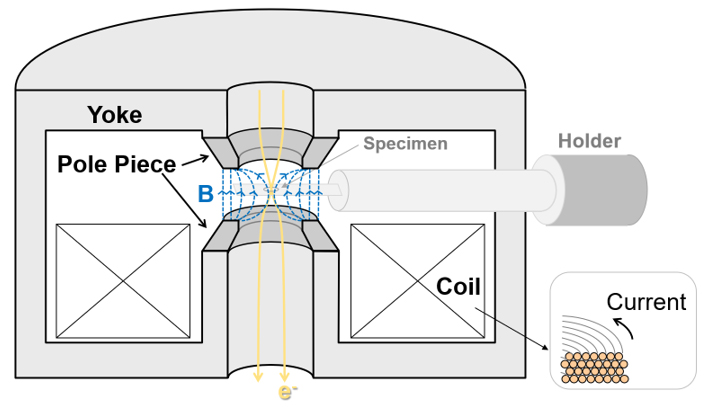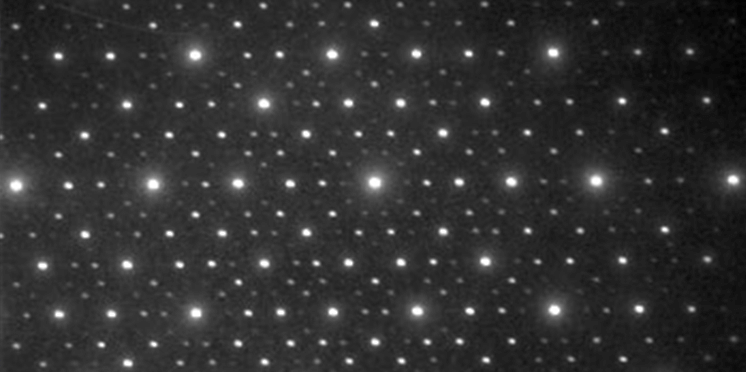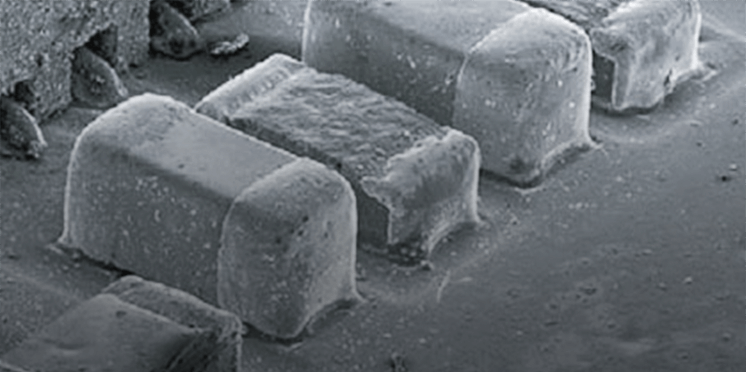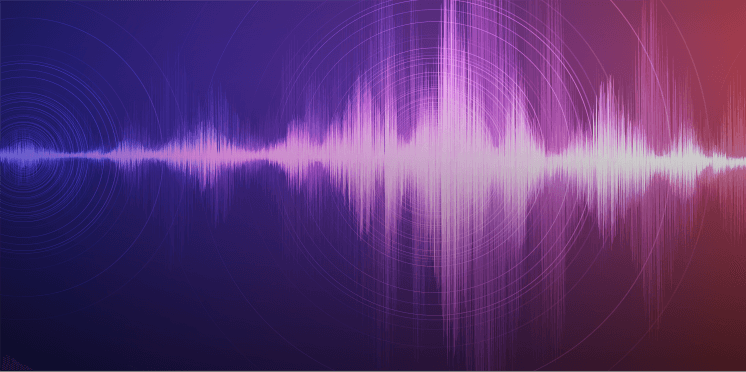対物レンズ(オブジェクティブレンズ)
対物レンズ(オブジェクティブレンズ)
objective lens
[目次:レンズ系]
試料を出射した電子で結像するための初段のレンズ。結像レンズ系の中で最も重要なレンズであり、対物レンズの性能が像の質(分解能、コントラストなど)を、ほぼ決める。良い対物レンズとは球面収差係数と色収差係数が小さいレンズである。これらの値を小さくするには、上極と下極の距離を短くすることとポールピースの穴径を小さくすることが必要である。両極の間には通常サイドエントリータイプの試料ホルダが入るので、距離を短くするには限度がある。トップエントリータイプのホルダに対しては上極の穴径が下極の穴径より大きい非対称なポールピースが使われる。

図:対物レンズは、レンズの磁場を決めるポールピース、磁路を作るためのヨーク(Yoke)、コイルからなる。コイルはヨークの中で光軸に対して円周上に巻かれており、それに電流を流して磁場を発生させる。磁束がヨーク内に作られ、ヨークの先に取り付けられたポールピースから真空中に磁場を漏洩させる。ポールピースとは磁場を漏洩させる隙間(ギャップ)を持つ磁性体の部品で、図のように円筒対称形状をしており、電子線はその中心部分を通る。
この漏れ磁場(B)は、図に示すように曲線状になっており、この部分を通過する電子線を曲げるレンズとして働く。コイルに流れる電流を可変することにより、対物レンズの強さを変えることができる。試料は、通常サイドエントリータイプのホルダーにセットされ、ポールピースが作る磁場の中に置かれる。
ポールピースは磁場の強さや形状すなわちレンズの性能を左右するため、ヨークより高品質な材料で作られており、高い精度で加工されている。対物レンズは、中間レンズなどのレンズに比べて、焦点距離が短いので強い磁場が必要で、飽和磁化の大きい磁性体が使われる。
特に、高空間分解能観察用の対物レンズには、レンズの収差を小さくするためにさらに強い磁場が必要で、そのために磁極の間隔(ギャップ)の狭いポールピースが用いられる。他方、元素分析用の対物レンズには、EDS検出器を試料に近づけて検出感度を上げたり、試料の傾斜角度を大きくするために、分解能を少し犠牲にして、ギャップの少し広いポールピースが使われる。
The "objective lens" is the first-stage lens to form an image using electrons exiting from the specimen. The objective lens is the most important lens in the imaging lens system because the performance of this lens determines the image quality (resolution, contrast, etc). A good objective lens has both a small spherical aberration (Cs) coefficient and a small chromatic aberration (Cc) coefficient. To decrease these coefficients, shortening the distance between the two magnetic poles and decreasing the bore diameter of the polepiece are required. Since the side-entry-type specimen holder is inserted between the two magnetic poles, there is a limitation on shortening the distance. For the top-entry-type specimen holder, an asymmetric polepiece whose upper bore diameter is larger than that of the lower one is used.

Fig. The objective lens consists of a polepiece to determine the magnetic-field of the lens, a yoke to create a magnetic path, and a copper wire coil. The coil is wound in the yoke around the circumference of the optical axis. A magnetic field is generated by the electric current passing through the coil and a magnetic flux is generated in the yoke. Then, a leakage magnetic field is created in vacuum from the polepiece attached to the end of the yoke. The polepiece of the lens is made of a magnetic component and has a gap to create a leakage magnetic field. As is seen in Figure, the polepiece is cylindrically symmetric and an electron beam passes through the center of the polepiece.
The leakage magnetic field (B) has a curvature (shown in Figure) and acts as a lens to converge the electron beam. The strength of the lens can be varied by changing the electric current of the coil. A specimen usually set on a side-entry type holder is placed in the magnetic field (lens) produced by the polepiece.
The polepiece determines the performance of the lens, that is, the strength and shape of the magnetic field of the lens. Thus, the polepiece is made of a high-quality magnetic material than that of the yoke and is processed by high precision machining.
The objective lens is requested to possess a stronger magnetic field than the intermediate lens, etc., because the focal length of the objective lens is shorter than the other lens. To meet this requirement, the objective lens is made of a magnetic material with a large saturation magnetization.
The objective lens used for high spatial-resolution observation requires a further-stronger magnetic field to decrease the aberration of the lens. For this purpose, a polepiece with a narrow gap (a short distance between the upper and lower poles) is used. On the other hand, the objective lens used for element analysis uses a polepiece with a little wider gap at a little sacrifice of image resolution because a more space is needed for an EDS detector to place close to the specimen for increasing the detection efficiency or to ensure a large tilt angle of the specimen.
関連用語から探す
説明に「対物レンズ(オブジェクティブレンズ)」が含まれている用語






